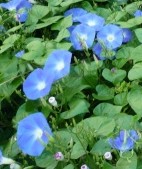
Native to the New World tropics this tender perennial vine is a member of the Convolvulaceae family that also includes sweet potato, cypress vine, and dodder. The plant grows up to 13′ long and has alternate, heart-shaped leaves that are 3-6″ long. Beginning in mid summer large buds open in the morning into trumpet-shaped flowers 1-2″ across in white, or shades of blue or pink. By noon the flowers begin to fade but the process begins again each day and continues until frost. Morning glory will grow on a trellis or arbor by twinning its hairy stems as it grows upward. Plants tend to reseed and can become a noxious weed in some areas but their lush green foliage and profusion of flowers make them a welcome addition to any garden. And, hummingbirds love them. Many cultivars are available including heirloom varieties that fit well into a cottage garden. The genus name Ipomea comes from the Greek words ips meaning worm and homoios meaning resembling, and refers to the twining nature of the plant. The specific epithet, tricolor, comes from the Latin words tres, meaning three, and color meaning color or hue.
Type: Tender perennial vine grown as annual
Bloom: Large trumpet-shaped flowers in white, pink, or blue open in morning from mid- to late-summer until frost.
Foliage: Lush, dark green, heart-shaped leaves
Size: 6-13’ H x 1” W (if grown upward)
Light: Full sun
Soil: Average, moist, well-drained
Fertilizer: Too much fertilizer leads to lush foliage growth at the expense of flowers.
Care: Help vines find structures to grow upward
Pests and Diseases: None of significance
Propagation: Seed
Outstanding Selection:

- ‘Heavenly Blue’ (heirloom)

- ‘Flying Saucer’ (sky blue, with streaks of white and a sunny yellow center; tolerates some shade)

- ‘Grandpa Ott’ (dark purple blossoms with a red star-shaped throat)
